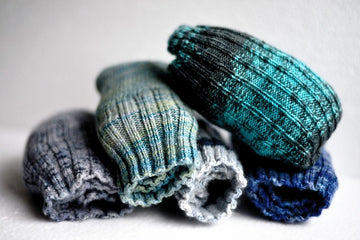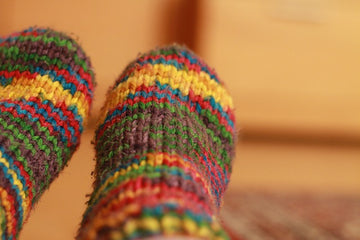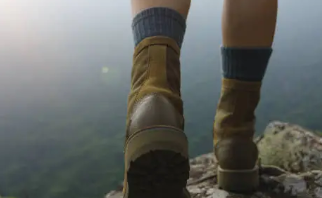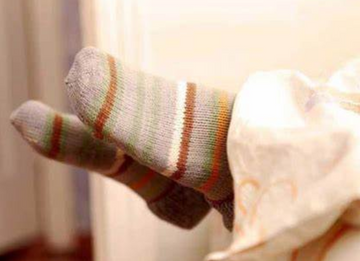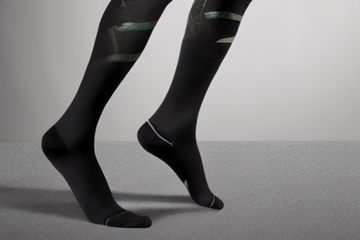
Compression socks are specialized garments that apply gentle pressure to the legs and feet. This pressure helps improve circulation by assisting blood flow back towards the heart. Commonly worn by people who experience leg discomfort, swelling, or circulation issues, compression socks come in various lengths, strengths, and with graduated compression (tighter at the ankle, looser as it goes up).
What Are Compression Socks
Compression socks, also referred to as compression stockings, are specialized garments designed to apply gentle pressure to the legs and feet. This pressure helps improve blood circulation by assisting the veins in moving blood back toward the heart. Compression socks are commonly worn by individuals who experience discomfort, swelling, or circulation issues in their legs, such as those caused by prolonged sitting or standing, pregnancy, or certain medical conditions.
These socks are available in various lengths, including knee-high, thigh-high, and full-length options, and they come in different levels of compression, ranging from mild to extra firm. Some compression socks feature graduated compression, meaning the pressure is highest at the ankle and gradually decreases as it moves up the leg, which aids in venous return.
How Do Compression Socks Work
Compression socks work by applying gentle pressure to the legs and feet, which helps improve circulation and prevents blood from pooling in the lower extremities.
- Graduated Compression
The key feature is the tighter squeeze at the ankle that loosens as it goes up the leg. This pressure gradient helps blood flow upwards towards the heart instead of pooling in the legs.
- Improved Blood Flow
By squeezing the veins and tissues, compression socks make it easier for blood to return to the heart. This reduces pressure in the veins and prevents blood from pooling.
- Reduced Risk of Blood Clots
Pooling blood can increase the risk of blood clots. Compression socks help prevent this by promoting healthy blood flow.
- Muscle Recovery
While research is ongoing, compression socks may also aid athletes in recovering faster after exercise by reducing muscle soreness and cramping.
How Do Compression Socks Work for Plantar Fasciitis
Compression socks can be helpful in managing plantar fasciitis in a few ways:
- Support for the plantar fascia
The targeted compression around the arch area acts like a gentle brace for the plantar fascia ligament. This can provide some stability and reduce strain when you're not putting weight on your feet, potentially lessening pain upon waking or after long periods of sitting.
- Reduced inflammation
Compression can help decrease swelling and inflammation in the plantar fascia, which is a key contributor to pain. By promoting blood flow and reducing fluid buildup, compression socks can aid in the healing process.
- Improved circulation
Plantar fasciitis healing can benefit from increased blood flow to the area. Compression socks, by squeezing the tissues and veins, may help improve circulation and bring essential nutrients for healing to the injured area.
How Do Compression Socks Work for Varicose Veins
Compression socks are a valuable tool in managing varicose veins. Here's a closer look at how they work:
- Graduated Compression
The tightest squeeze is applied at the ankle and gradually loosens as the sock moves up the leg. This pressure gradient helps blood flow upwards towards the heart, counteracting the malfunctioning valves in varicose veins that allow blood to pool downwards.
- Squeezing the Veins
The targeted compression helps to squeeze the enlarged varicose veins, reducing their size and improving their function. This allows blood to flow more easily through the veins and back towards the heart.
- Improved Valve Function
While compression socks can't directly fix damaged valves, the external pressure can help them close more effectively, preventing blood from flowing backwards and pooling in the veins.
- Reduced Symptoms
By improving blood flow and reducing pressure within the veins, compression socks can help alleviate various symptoms associated with varicose veins, such as pain, swelling, fatigue, and achiness.
How Do Compression Socks Work for Swelling
Compression socks work wonders for reducing swelling in the legs by tackling the root cause: poor blood circulation.
- Graduated Pressure
Compression socks are designed with graduated compression, meaning they exert the strongest squeeze at the ankle and gradually loosen as they move up the leg. This pressure gradient helps counteract the natural tendency of fluids to pool in the lower extremities.
- Improved Blood Flow
The gentle squeezing action of the socks on the veins and leg tissues helps push blood back towards the heart more efficiently. This reduces pressure within the veins and prevents blood from accumulating, thereby minimizing swelling.
- Reduced Fluid Buildup
By promoting healthy blood flow, compression socks help prevent excess fluid from leaking out of the veins and into the surrounding tissues, which is a major contributor to swelling.
Who Should Use Compression Stockings
- Circulatory Problems
Compression stockings are particularly useful for individuals with conditions that impair circulation, such as deep vein thrombosis (DVT), varicose veins, and diabetes. By promoting blood flow and preventing blood pooling, they can help reduce the risk of complications associated with these conditions.
- Post-Surgical Recovery
Following surgery, especially leg surgeries, swelling and blood clots can be a concern. Compression stockings can aid recovery by minimizing swelling and promoting blood circulation.
- Lymphedema
This condition involves a buildup of fluid due to a malfunctioning lymphatic system. Compression stockings can help manage lymphedema by promoting fluid drainage and reducing swelling.
- Limited Mobility
For people who are bedridden or have difficulty moving their legs, compression stockings can help prevent blood clots and improve circulation.
- Prolonged Sitting or Standing
Jobs that require prolonged sitting or standing can lead to leg fatigue, swelling, and discomfort. Compression stockings can help counteract these issues by promoting circulation and reducing pressure in the legs.
- Athletes
Many athletes wear compression socks to enhance performance or recovery. While research on their effectiveness for performance enhancement is ongoing, compression socks can potentially aid muscle recovery after exercise by reducing soreness and cramping.
- Pregnancy
Pregnant women are more susceptible to swelling in the legs. Compression stockings can provide relief from swelling and discomfort during pregnancy.
- Travel
Sitting for extended periods during air travel can increase the risk of blood clots. Compression stockings can be a helpful preventative measure for frequent flyers.
Who Should Not Wear Compression Socks?
Compression socks aren't for everyone. Here are the main cases where they might not be recommended.
- Peripheral Arterial Disease (PAD)
In PAD, the arteries in the legs are narrowed due to plaque buildup. Compression socks, by further restricting blood flow, could worsen the condition.
- Severe Heart Failure
People with severe heart failure may have difficulty pumping blood efficiently. Compression socks, by increasing pressure in the legs, could put additional strain on the heart.
- Skin Conditions
Open wounds, eczema, or severe allergies to the materials used in compression socks can be irritated by the pressure and friction.
- Neuropathy
For people with nerve damage (neuropathy), especially in the legs due to diabetes, they might not feel any discomfort from overly tight compression socks, potentially leading to skin breakdown.
Is There a Downside to Wearing Compression Socks?
While compression socks offer many benefits, there are a few potential downsides.
- Improper Fit
Wearing the wrong size compression socks is a major concern. Socks that are too tight can restrict blood flow and cause pain, while loose socks won't provide the intended therapeutic pressure.
- Skin Irritation
Tight-fitting socks can sometimes cause dry skin, redness, or itching, especially if you have sensitive skin or eczema. Choosing breathable, moisture-wicking materials can help minimize this issue.
- Discomfort
Compression socks can feel constricting or uncomfortable, especially when you first start wearing them. It usually takes some time to adjust to the sensation.
- Underlying Conditions
In some cases, compression socks might not be suitable. People with severe peripheral arterial disease (PAD) or heart failure could experience worsened circulation due to the pressure. Open wounds or skin conditions can also be irritated by compression socks.
- Bruising or Ulcers
In rare cases, very tight-fitting socks or those worn for extended periods might cause minor bruising or even skin ulcers.
How Many Hours a Day Should You Wear Compression Stockings?
With a doctor's approval, compression stockings can be worn for extended periods, even up to 24 hours a day. In fact, the National Health Service in the United Kingdom recommends surgery patients wear them as much as possible following surgery.
Why Do Nurses Wear Compression Socks?
Nurses are often on their feet for extended hours, which can lead to aches and pains in the legs and lower back. Compression socks provide support and can help minimize pain and discomfort throughout a long shift.
Is It Ok to Sleep in Compression Socks?
You can sleep in compression socks, but there are a few things to consider. While it can improve circulation and reduce swelling, it's not necessarily beneficial for everyone. Consulting a doctor is always recommended, especially if you have any underlying health conditions. Additionally, some compression socks might be designed for daytime wear and not suitable for sleeping in due to comfort factors.
Conclusion
Compression socks offer a range of benefits for circulation, swelling, and specific conditions. However, consulting a doctor for proper use and fit is important, especially for those with underlying health conditions.
Read More:
How to Measure for Compression Socks
How Do Compression Socks Work
Why Do My Legs Ache After Wearing Compression Socks
How to Put On Compression Socks
When to Put on Compression Socks for Flying
Are Flight Socks the Same as Compression Socks




